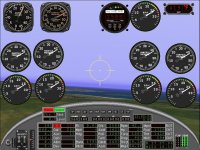300x300 best and standard size, perhaps?
Hello Ivan,
All the gauge-dial bitmaps I have doctored up, like e.g. the helicopter N2, or the Tank that I used for the Heinkel Jet, were all just over 300x300 pixel bitmaps. Needles, handbrakes and other smaller stuff are of course smaller.
I think it´s the big dials that have the larger 300x300 bitmaps, and maybe it´s the smaller temperature and pressure gauges that have the smaller 125x125 bitmaps.
I´ll try out different things later today with the programme "ResHacker" that I have here, to see what happens if I use a smaller bitmap to substitude a larger 300x300 one. I would expect some interpolation, which could make things more blurred, perhaps.
- I´ll even try and put a 600x600 in, if you like, just to see what happens.
More, later, after doing the shopping...
Update:
---------
OK, I did a few tests with different sized bitmaps.
It appears they are all automatically resized, which will affect the needle sizes if these are not re-sized accordingly as well.
The gauge I played with was the default FS98 Cessna EGT/CHT, that appears to have two dial bitmaps - one of 302x302 pixels for use in full screen view, and one of 152x152 pixels for windowed view.
If you put the big bitmap where the small one should be, then in the windowed mode, the gauge is made smaller to get the correct visual size. It loses clarity, as it loses pixels. The needle section gets smaller, out of proportion for the gauge, so I assume that the needle should also be made bigger.
The opposite also happens: If you put the smaller bitmap where the bigger one should go, the dial is automatically enlarged, and gets pixelized, but the needle will also be enlarged, and is far to big, unless that bitmap has been made smaller first.
If a 600x600 bitmap is used, it is minimized accordingly, and loses pixels and also clarity.
I wonder if these experiments shed any light on the question.
It appears that what is best when editing a gauge bitmap, is to use the same size bitmap as the one that comes with the gauge.
Cheers,
Aleatorylamp










